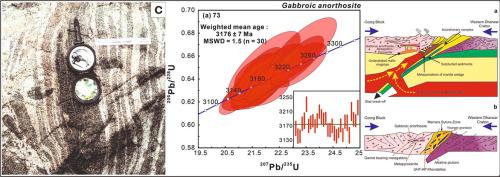Gondwana Research ( IF 7.2 ) Pub Date : 2021-08-02 , DOI: 10.1016/j.gr.2021.07.026 K.S. Anoop 1 , Y. Anilkumar 1 , M. Santosh 2, 3 , Bing Yu 2 , K. Delna Joy 1 , K.V. Kavyanjali 1 , Ajana Sathyan 1 , Anjana Mathew 1 , K.S. Sajinkumar 1, 4

|
As one of the oldest crustal blocks in Southern Peninsular India, the Coorg Block has been the focus of investigations related to crustal evolution in the early history of the Earth with implications on Mesoarchean plate tectonic processes. The Coorg Block is dominantly composed of arc magmatic rocks and bordered on the north by the Mercara Suture Zone, a Mesoproterozoic subduction-collision zone hosting extruded high-pressure and ultra-high temperature metapelitic and meta-mafic rocks. Here, we report the occurrence of a dismembered gabbro-anorthosite complex corresponding to a layered intrusion from the northern margin of the Coorg Block. We present results from an integrated study on the petrology, mineral chemistry, P-T phase equilibria, whole-rock geochemistry, and zircon and monazite U–Pb geochronology to understand the magmatic and metamorphic evolution of the layered intrusion and associated rocks. The geochemical data suggest that the parental magma was generated within a suprasubduction zone setting. Phase equilibrium modelling of garnet-bearing metagabbro from the Coorg Block suggests metamorphic P–T range of 10.5–11 kbar at 1000–1100 °C corresponding to ultra-high temperature conditions. The zircon U-Pb data from the various rock types of the mafic–ultramafic suite yield weighted mean ages at 3176 Ma, 3174 Ma, 3143 Ma, and 3124 Ma whereas the associated charnockite shows a slightly older age of 3319 ± 12 Ma. Metamorphic zircon from charnockite yield an age of 3101 Ma, close to the monazite age of 3110 ± 24 Ma from the same rock, constraining the timing of metamorphism as Mesoarchean, and marking the collisional event between the Coorg Block and the Dharwar Craton along the Mercara Suture Zone. We propose a tectonic model involving southward subduction of the Western Dharwar Block beneath the northern margin of the Coorg Block that can explain the extensive arc magmatism and suprasubduction zone rock suites, followed by ocean closure and collision along the Mercara Suture Zone, accompanied by high P-T metamorphism.
中文翻译:

印度南部 Coorg 地块层状辉长岩-斜长岩复合体的岩浆和变质演化:对中太古代超俯冲带过程的影响
作为印度半岛南部最古老的地壳块体之一,库格地块一直是地球早期历史中地壳演化研究的重点,对中太古代板块构造过程有影响。Coorg 地块主要由弧形岩浆岩组成,北部与 Mercara 缝合带接壤,该缝合带是一个中元古代俯冲碰撞带,包含挤压出的高压和超高温变泥质和变基性岩。在这里,我们报告了一个被肢解的辉长岩-斜长岩复合体的出现,对应于来自 Coorg Block 北缘的分层侵入。我们展示了对岩石学、矿物化学、PT 相平衡、全岩地球化学、和锆石和独居石 U-Pb 年代学,以了解层状侵入体和伴生岩石的岩浆和变质演化。地球化学数据表明母岩浆是在超俯冲带环境中产生的。来自 Coorg Block 的含石榴石变辉长岩的相平衡模型表明,在 1000-1100 °C 下变质 P-T 范围为 10.5-11 kbar,对应于超高温条件。来自镁铁质-超镁铁质套件的各种岩石类型的锆石 U-Pb 数据产生的加权平均年龄为 3176 Ma、3174 Ma、3143 Ma 和 3124 Ma,而相关的硬质镁石显示年龄稍大,为 3319 ± 12 Ma。来自charnockite的变质锆石的年龄为3101 Ma,接近同一岩石的独居石年龄3110±24 Ma,限制了变质的时间为中太古代,并标志着沿 Mercara 缝合带的 Coorg Block 和 Dharwar Craton 之间的碰撞事件。我们提出了一个涉及 Coorg 地块北缘下西 Dharwar 地块向南俯冲的构造模型,可以解释广泛的弧形岩浆作用和超俯冲带岩石套件,随后是沿 Mercara 缝合带的海洋闭合和碰撞,伴随着高 PT变质。


















































 京公网安备 11010802027423号
京公网安备 11010802027423号